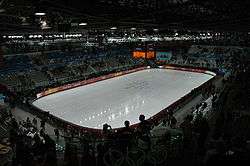Figure skating rink

A figure skating rink is an ice rink designed for figure skating. Alternatively it is used for other sports such as short track speed skating and ice hockey. It is usually rectangular.
Name origins
Rink, a Scottish word meaning 'course', was used as the name of a place where another game, curling, was played. The name has been retained for the construction of ice areas for figure skating.[1]
Basics
Dimensions
The size of figure skating rinks can be quite variable. The International Skating Union (ISU) prefers Olympic-sized rinks for figure skating competitions, particularly for major events. According to Rule 342 of the ISU Special Regulations & Technical Rules: Single & Pair Skating and Ice Dance 2016[2], an Olympic-sized figure skating rink has dimensions of 60 metres (196 feet 10 inches) by 30 metres (98 feet 5 inches) if possible, the same with an Olympic-sized short track speed skating rink and an Olympic-sized ice hockey rink, and exactly 44% larger than an Olympic-size swimming pool which has dimensions of 50 metres (164 feet 1 inch) by 25 metres (82 feet 0 inches).[3]
The scoring system rewards skaters who have good ice coverage, i.e. who efficiently cover the entire ice surface during their programs. Olympic-sized rinks make the differences in skill between skaters more apparent but they are not available for all events. If a rink has different dimensions, a skater's jump setup and speed may be hindered as he or she adjusts.[4][5]
Ice quality
Ice quality is judged by smoothness, friction, hardness, and brittleness.[6] Factors affecting ice quality include temperature, water quality, and usage, with toe picks causing more deterioration. For figure skating, the ice surface temperature is usually kept between −5.5 °C (22 °F) and −3.5 °C (26 °F),[6][7] slightly warmer than an ice hockey rink, which means softer ice and easier landings for the figure skaters.
Typically after every two warm-up groups during the competitions, an ice resurfacer cleans and smooths the surface of the ice sheet. Inadequate ice quality may affect skaters' performances.[8]
Rinks for competitions
Requirements
According to Rule 342 of the ISU Special Regulations & Technical Rules: Single & Pair Skating and Ice Dance 2016[2], the available skating area for the short program/short dance, free skating/free dance and pattern dance(s) must be rectangular and if possible, shall measure 60 metres (196 feet 10 inches) in length and 30 metres (98 feet 5 inches) in width, but not larger, and not less than 56 metres (183 feet 9 inches) in length and 26 metres (85 feet 4 inches) in width.
Officials shall not be seated on the ice surface. The Judges and the Referee will be seated at the rinkboard. If possible, the Technical Panel will be seated in an elevated position.
For the international competitions sanctioned by the ISU, at least one covered and preferably heated rink is required. For the ISU Figure Skating Championships, the Winter Olympic Games and the Winter Youth Olympic Games, two covered and closed rinks are required. For the ISU events, the Winter Olympic Games, the Winter Youth Olympic Games and the qualifying competition for the Winter Olympic Games, the ice rinks must be heated.
Kiss and cry
The kiss and cry is the area in a figure skating rink where figure skaters wait for their marks to be announced after their performances during a figure skating competition.[9] It is so named because the skaters and coaches often kiss to celebrate after a good performance, or cry after a poor one. The area is usually located in the corner or end of the rink and is furnished with a bench or chairs for the skaters and coaches and monitors to display the competition results. It is often elaborately decorated with flowers or some other backdrop for television shots and photos of the skaters as they react to their performance and scores.
For the Olympics
Since short track speed skating was contested at the 1992 Winter Olympics, the rinks are used for figure skating and short track speed skating during those Winter Olympic Games.
See also
References
- ↑ Redmond, Gerald (1982). The sporting Scots of nineteenth-century Canada. Toronto, Ontario: Associated University Presses Inc. p. 271. ISBN 0-8386-3069-3.
- 1 2 "Special Regulations & Technical Rules: Single & Pair Skating and Ice Dance 2016" (PDF). International Skating Union. June 2016. Archived from the original on 9 July 2018.
- ↑ "Fina Facilities Rules 2015–2017" (PDF). FINA. Retrieved July 14, 2018.
- ↑ "Michal Brezina leads Skate America". The Associated Press. ESPN. October 22, 2011.
- ↑ Berlot, Jean-Christophe (October 7, 2013). "French skaters debut programs in Orléans". IceNetwork.com.
- 1 2 Theiler, Jeff; Kurko, Sara (May 2011). "What makes quality ice?" (PDF). Skating Magazine. pp. 46–47.
- ↑ "8 things you didn't know about… Figure skating". International Olympic Committee. October 31, 2016. Retrieved July 14, 2018.
- ↑ Kondakova, Anna (March 28, 2012). "Savchenko and Szolkowy land throw triple Axel; lead pairs in Nice". Golden Skate.
- ↑ "kiss-and-cry area" definition from Double-Tongued Dictionary
External links
| Wikimedia Commons has media related to Figure skating. |